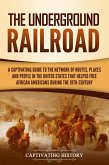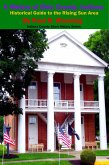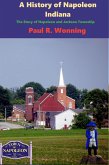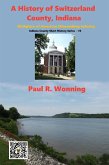This book is a collection of personal vignettes, a mystery detective novel that turns oral legend into history. Montgomery County, Indiana's history of the Underground Railroad focuses on the people involved. Documentation recounts few feats of derring-do and midnight runs through the woods in our county's past. While this book does have a few escape stories, both successful and unsuccessful, it tells more about the lives and backgrounds of the people who made the choice to help those seeking freedom and those who made their homes here after leaving lives of oppression. What is included within these pages is a story about people who, by choice, were bound together by a common purpose.
Montgomery County, Indiana holds a special place on the Western spur of Indiana's Underground Railroad. Indiana's landscape provided all the natural formations that allowed runaways traversing the state to conceal themselves and to follow nature's signs northward. Montgomery County boasted existing footpaths, flat terrains, Sugar Creek that ran northeast to southwest, tree hollows, caves, forests, thickets, geese flying north, moss growing thicker on the north side of the trees, rising and setting of the sun, and, of course, the most notable of nature's gifts, the North Star. Abolitionists/Activists smuggled escapees in boats, carriages, stagecoaches, railroad cars, false bottom wagons, and skiffs while they hid them in barns, haystacks, corn cribs, drainpipes, barrels, trunks, old furniture, coffins, and overturned canoes. Slave songs and spirituals often gave directions, coded messages, and helpful suggestions for those preparing to or travelling on the Underground Railroad.
Indiana's Underground Railroad western spur came up through places like Leavenworth, Lawrenceburg, New Albany, and Evansville. Depending on circumstances (patrollers, bounty hunters, weather), conductors routed runaways northward through Vincennes, Terre Haute, Bloomingdale, Alamo, Yountsville, Crawfordsville, Garfield, Darlington, Michigan, and eventually to Canada. However, these inner workings of our western route have remained shrouded in mystery. Historians have suggested many reasons for this. Those who did settle here brought their secret tactics from the East Coast knowing how to conceal their movements. Local conductors had a greater fear for their own protection and the safety of their families. The Western side of the state was sparsely settled until later in the state's history. In 1824, Crawfordsville found itself isolated being the only town between Terre Haute and Fort Wayne. Conductors hid or destroyed journals, or chose never to keep them. The total number aided to freedom, or where they stayed during their journey through this area of the state will never be known.
Specific details about how the Underground Railroad organization began in Montgomery County have been lost to time. Because very few specific written records exist, some historians have classified all local stories as Montgomery County legends. But like all legends, the stories had facts at the core. While historians assumed the traffic was never very heavy since more legends haven't been told, it may have instead been a matter of self-preservation with carefully guarded secrets. The only real concrete remnants of these legends include verified homes such as Crawfordsville's Speed Cabin, Alamo's Hiram Powell home, and Yountsville's Abijah O'Neall home, the Bethel African Methodist Episcopal Church in Crawfordsville's Northend, and some letters preserved by descendants.
Montgomery County, Indiana holds a special place on the Western spur of Indiana's Underground Railroad. Indiana's landscape provided all the natural formations that allowed runaways traversing the state to conceal themselves and to follow nature's signs northward. Montgomery County boasted existing footpaths, flat terrains, Sugar Creek that ran northeast to southwest, tree hollows, caves, forests, thickets, geese flying north, moss growing thicker on the north side of the trees, rising and setting of the sun, and, of course, the most notable of nature's gifts, the North Star. Abolitionists/Activists smuggled escapees in boats, carriages, stagecoaches, railroad cars, false bottom wagons, and skiffs while they hid them in barns, haystacks, corn cribs, drainpipes, barrels, trunks, old furniture, coffins, and overturned canoes. Slave songs and spirituals often gave directions, coded messages, and helpful suggestions for those preparing to or travelling on the Underground Railroad.
Indiana's Underground Railroad western spur came up through places like Leavenworth, Lawrenceburg, New Albany, and Evansville. Depending on circumstances (patrollers, bounty hunters, weather), conductors routed runaways northward through Vincennes, Terre Haute, Bloomingdale, Alamo, Yountsville, Crawfordsville, Garfield, Darlington, Michigan, and eventually to Canada. However, these inner workings of our western route have remained shrouded in mystery. Historians have suggested many reasons for this. Those who did settle here brought their secret tactics from the East Coast knowing how to conceal their movements. Local conductors had a greater fear for their own protection and the safety of their families. The Western side of the state was sparsely settled until later in the state's history. In 1824, Crawfordsville found itself isolated being the only town between Terre Haute and Fort Wayne. Conductors hid or destroyed journals, or chose never to keep them. The total number aided to freedom, or where they stayed during their journey through this area of the state will never be known.
Specific details about how the Underground Railroad organization began in Montgomery County have been lost to time. Because very few specific written records exist, some historians have classified all local stories as Montgomery County legends. But like all legends, the stories had facts at the core. While historians assumed the traffic was never very heavy since more legends haven't been told, it may have instead been a matter of self-preservation with carefully guarded secrets. The only real concrete remnants of these legends include verified homes such as Crawfordsville's Speed Cabin, Alamo's Hiram Powell home, and Yountsville's Abijah O'Neall home, the Bethel African Methodist Episcopal Church in Crawfordsville's Northend, and some letters preserved by descendants.
Dieser Download kann aus rechtlichen Gründen nur mit Rechnungsadresse in A, B, CY, CZ, D, DK, EW, E, FIN, F, GR, H, IRL, I, LT, L, LR, M, NL, PL, P, R, S, SLO, SK ausgeliefert werden.









